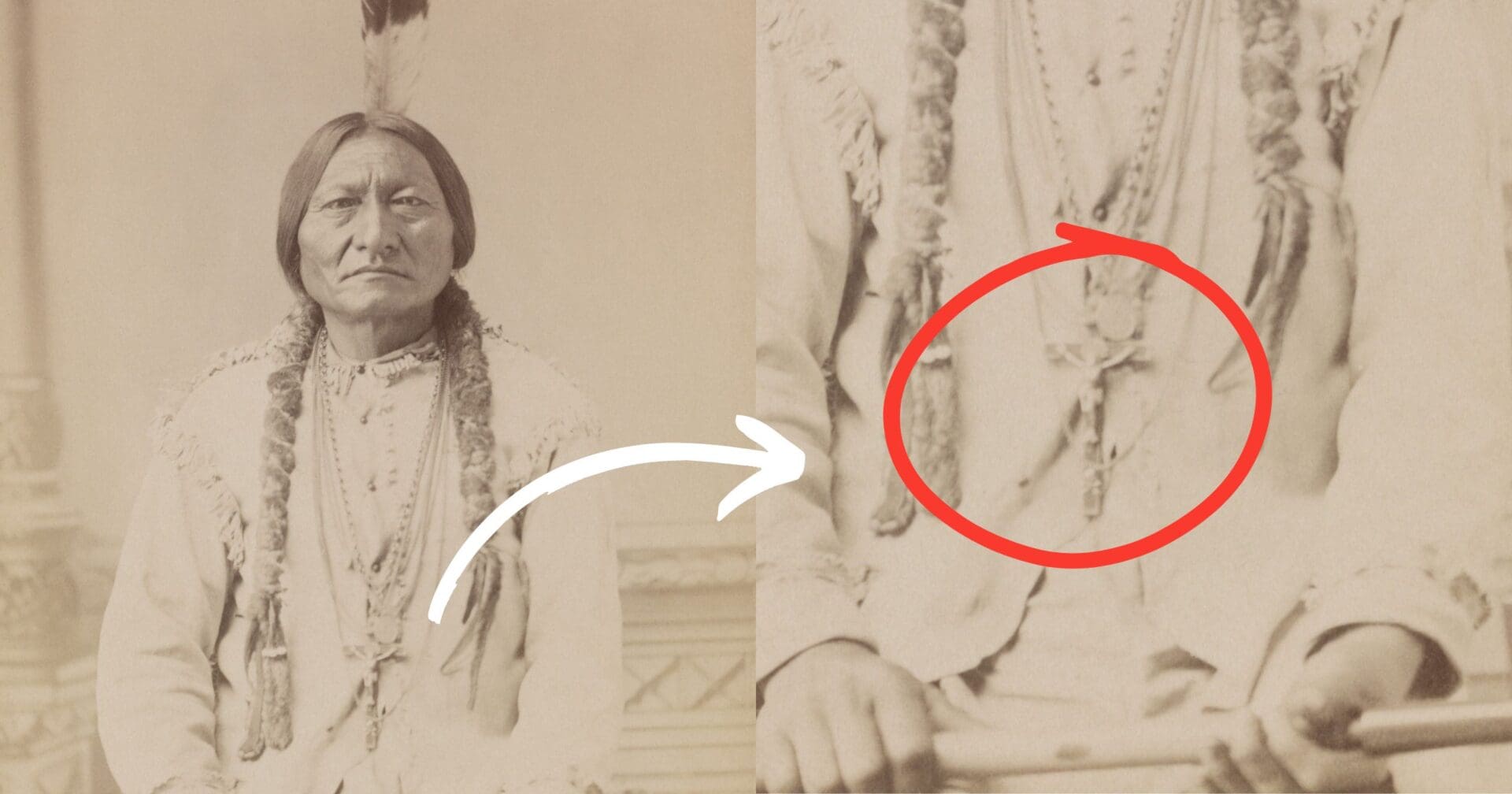Sitting Bull is the legendary first chieftain of the entire Lakota Sioux nation, a commonplace figure among the Wild West history of the American Frontier. Most everyone in grade school learns the history of his involvement with resistance against the government, his time spent with Buffalo Bill, and his unfortunate death. What most people don’t know about him, however, is that Sitting Bull wore a crucifix. Here’s why…
While most learn about Sitting Bull and the American Indians, most don’t learn about the great work done by Catholic missionary priests on the American Frontier. The most famous of these priests was the Jesuit missionary Pierre-Jean De Smet, one of the rare few trusted by the Lakota Sioux and a personal great friend of Chief Sitting Bull who became known as “Friend of Sitting Bull.”
The Sioux, especially Chief Sitting Bull, greatly admired the “black-robes,” as they called the missionaries. Father De Smet was so loved he was able to walk into an entire camp of five thousand unarmed and be greeted with welcome arms. Father De Smet first met Sitting Bull in 1848, when he was 17 and De Smet was 47. Bishop Thomas O’Gorman records in 1904:
“Father De Smet has left a complete record of his visit made in the summer of 1848, but says he was impelled to make that visit by interest aroused during a ‘transient visit to some tribes of Sioux, on the upper-Missouri, on my way back from the Rocky mountains.'”
While Father De Smet and Sitting Bull would likely have had multiple further encounters from 1848-1870, there is no baptismal record of Sitting Bull nor did De Smet ever mention it in his writings. Because Sitting Bull had multiple wives he did not give up, it remained an obstacle to his acceptance into the Church his entire life. The legend that he was a baptized most likely spawned from a New York Times article on September 23rd, 1883 that hints at the possibility of him becoming Catholic:
“An unforeseen obstacle to his [Sitting Bull’s] reception has been met in the shape of two wives, neither of whom Sitting Bull can make up his mind to part with. Until the red man brings himself to put aside one or the other of his marital companions he will be debarred entrance.”
If he wasn’t Catholic, why did he wear a crucifix? The answer to the reason why comes from a meeting in June of 1868, when Father De Smet met with Chief Sitting Bull near Fort Rice in efforts to gather signatures for the Treaty of Fort Laramie. When he arrived, one of the chiefs there told him: “If it had been any other man than you, Black-robe, this day would have been his last.”
During this meeting, Father De Smet presented Sitting Bull and principal war leaders American Cross and Two Bears with a crucifix and convinced the Sioux people to sign the treaty. When De Smet returned, General Stanley remarked that “Father De Smet alone of the entire white race could penetrate to these cruel savages and return safe and sound.”
This crucifix he received from Father De Smet in 1868 was the same one he wore in his most famous portrait taken in 1885. If you look closely, the crucifix has skull bones on its bottom. This type of crucifix was popular with Jesuit missionaries at the time because the world Calvary means “the skull,” meant to be a reminder of the story of Salvation and why Christ died for us.
Editorial credit: Everett Collection / Shutterstock.com
















Great article!
What sources did you use? I would love to read more on this!
Please tell us about Quana Parker and his Catholic beliefs.
The skull and bones are those of Adam, who, according to tradition, was buried at Golgotha.
Yes — this knowledge has been largely lost in the West.
fascinating story!
Have read the biography of father DeSmet and his love and sacrifice for Native Americans in both the US and in Canada.
In travels into the west and western Canada I am amazed at all the places he visited and the missions he established.
Reflecting on his work, his suffering and desire to see peace between native Americans and Europeans, can not figure out why Fr De Smet has not been made a saint
Have read the biography of father DeSmet and his love and sacrifice for Native Americans in both the US and in Canada.
In travels into the west and western Canada I am amazed at all the places he visited and the missions he established.
Reflecting on his work, can not figure out why Fr De Smet has not been made a saint
Great article, Billy! And “Peace and Blessings” from us here in Northern Summit County (Akron) Ohio. We attend St. Mary Church here in Hudson.
Agreed!
Great story. I wonder if that crucifix was Father De Smet’s mission cross? If so, the gift to Sitting Bull is even more meaningful and powerful.
Are there many of the crucifix worn by sitting bull available ?